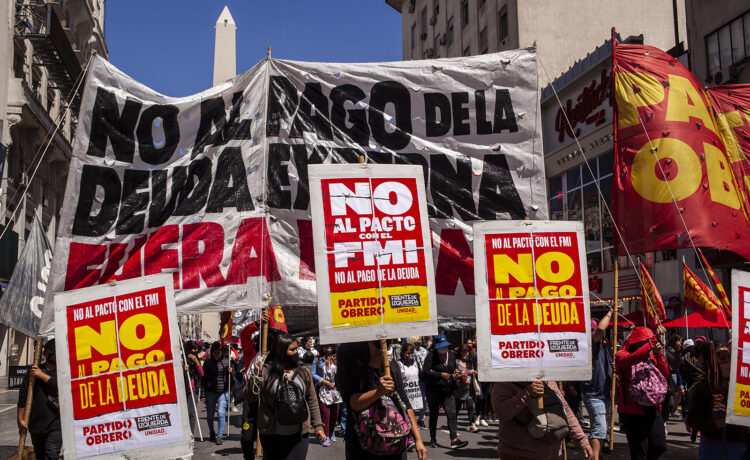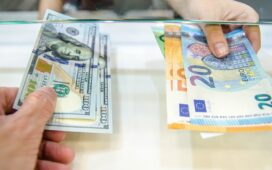Introduction
Since its inception in July 1944, the International Monetary Fund (IMF) has undergone considerable change as chief steward of the world’s monetary system. Officially charged with managing the global regime of exchange rates and international payments that allows nations to do business with one another, the fund recast itself in a broader, more active role following the 1973 collapse of fixed exchange rates, seeking to mitigate debt crises in developing countries from Asia to Latin America. It gained renewed relevance as the European sovereign debt crisis unfolded in 2010, and as the COVID-19 pandemic and the Russian invasion of Ukraine triggered global economic instability a decade later.
More From Our Experts
The fund has received both criticism and credit for its efforts to promote financial stability. Some economists say the fund has made major changes, including by expanding lending capacity, enacting governance reform, and moving away from free market fundamentalism. However, others suggest that the IMF must go further in implementing changes that will improve the plight of the world’s poor and guarantee the fund’s relevance, especially as climate change takes a mounting toll on the developing world.
A Postwar Financial Order
More on:
As World War II came to a close, forty-four allied nations convened at the Bretton Woods Conference in 1944 to establish a postwar financial order that would facilitate economic cooperation and prevent a rehash of the currency warfare that helped usher in the Great Depression. The new regime was intended to foster sustainable economic growth, promote higher standards of living, and reduce poverty. The historic accord founded the twin institutions of the World Bank and the IMF and required signatory countries to peg their currencies to the U.S. dollar. However, the system of fixed exchange rates broke down in the late 1960s and early 1970s due to an overvaluation of the U.S. dollar and President Richard Nixon’s decision to suspend the greenback’s convertibility into gold.
Unlike the World Bank, which was designed as a lending institution focused on longer-term development and social projects, the IMF was conceived as a watchdog of the monetary and exchange rate policies vital to global markets.
The IMF is akin to a credit union that permits its membership access to a common pool of resources—funds that represent the financial commitment or quota contributed by each nation, relative to its size. In theory, members with balance-of-payments trouble seek recourse with the IMF to buy time to rectify their economic policies and restore growth. The fund pursues its mission in three fundamental ways:
More From Our Experts
Surveillance. A formal system of review monitors the global economic and financial system as well as its member countries, and offers macroeconomic and financial policy advice.
Technical assistance. Practical support and training directed mainly at low- and middle-income countries help manage their economies.
More on:
Lending. The fund gives loans to member countries that are struggling with economic problems. Loans are provided in return for implementing specific IMF conditions designed to put government finances on a sustainable footing and restore growth. These policies have included balancing the budget, removing state subsidies, privatizing state enterprises, liberalizing trade and currency policy, and removing barriers to foreign investment and capital flows.
Since October 2019, the IMF has been led by Managing Director Kristalina Georgieva, the second woman to be selected for the role. Georgieva, a native of Bulgaria, was previously the acting president of the IMF’s twin institution, the World Bank.
The Crisis Management Role
The IMF has been called the world’s “financial crisis firefighter,” relied on by member countries to deal with crippling sovereign debt and prevent contagion from spreading through the global financial system.
A member country—there are 190 members as of 2023—typically summons the IMF when it can no longer finance imports or service its debt to creditors, a sign of potential, or actual, crisis. If the country and lender agree on a set of conditions, the fund will extend the government a loan and help organize a new debt-repayment schedule, if needed, that the country can manage. In exchange, the member agrees to implement reforms designed to rectify its balance of payments and restore foreign exchange reserves in its central bank. Nonetheless, member countries are responsible for their own reform programs, with the IMF supporting viable policies on a conditional basis.
Historically, much of the fund’s work has been done in emerging markets and developing countries, including interventions in Argentina, Brazil, Indonesia, and Mexico. The 2008 global financial crisis and subsequent European debt crisis required major bailouts in advanced eurozone economies for the first time in decades. This shift was epitomized by the IMF’s intervention in Greece, where the fund, the European Commission (EC), and the European Central Bank (ECB)—together called the troika—pledged $375 billion in three separate bailouts over eight years. The Greek lending program [PDF] marked the first time the IMF lent to a eurozone country since the euro began circulating in 2002. The size of the assistance package relative to Greece’s IMF membership contribution—usually limited to 600 percent—was also extraordinary: at 3,200 percent, it was the largest such package granted to a member country at the time. However, amid fallout from the pandemic and the war in Ukraine, the lender’s focus returned to the developing world, as many low-income countries experienced renewed debt crises.
The IMF and Its Discontents
The IMF has drawn vocal criticism over the years. In his 2002 book, Globalization and Its Discontents, Nobel Prize–winning economist Joseph Stiglitz denounced the fund as a primary culprit in the failed development policies implemented in some of the world’s poorest countries. He argues that many of the economic reforms the IMF required as conditions for its lending—fiscal austerity, high interest rates, trade liberalization, privatization, and open capital markets—have often been counterproductive for target economies and devastating for local populations.
The fund has also been criticized on the basis of overreach or “mission creep.” William Easterly, an economist at New York University, acknowledges some IMF successes [PDF] in firefighting financial crises in Mexico and East Asian countries in the mid-1990s, but he criticizes many of the fund’s interventions in severely impoverished countries, particularly in Africa and Latin America, as overly ambitious and intrusive. In addition, he describes many of the fund’s loan conditions and technical advice as out of touch with ground-level realities.
In recent years, the IMF’s work in more advanced economies has drawn ire as well, and at times forced some rethinking. The harsh terms of the Greek bailout led voters to reject austerity measures in a referendum, though the government later ignored the results and accepted the loans. The country’s political turmoil and grim economic outlook also led some IMF economists to advocate for debt forgiveness, putting the fund at odds with the rest of the troika.
Measuring Success
Supporters counter that the IMF is routinely identified with economic hardship and political ferment because it is only in times of crisis that states seek its services. Many countries approach the fund only after they have lost access to capital markets and other financial resources, despite maintaining commitments that stretch them beyond their means. Some experts point out that IMF reform programs favor gradual and orderly adjustment paths that are less disruptive to recipient governments than a rapid course-correction; absent the IMF’s presence, they argue, the overall harm to struggling economies would be worse. The fund is thus often the only organization equipped for such projects, and evaluating the fund’s success over the past seventy-plus years is a difficult task. As Harvard economist Benjamin M. Friedman has argued, “We cannot reliably know whether the consequences of the IMF’s policies were worse than whatever the alternative would have been.”
Some economists characterize the fund’s performance in the Asian financial crisis of 1997–98 as a success. They argue that the economic reforms championed by the IMF allowed the countries involved to recover quickly and laid the foundation for sustained growth during the 2000s. Others point to the fund’s role in Brazil in 2002 as positive: an early recovery there after intervention allowed IMF loans to be repaid ahead of schedule.
Meanwhile, the debate over the outcomes of the European bailout program has yet to be settled. Supporters of the troika approach say that eurozone countries implemented much needed reforms and resumed economic growth after they received bailouts, though critics counter that the damage was deep and that costly austerity measures did not yield a full economic recovery: youth unemployment and debt loads remain high even as some economies are still far smaller than before the crisis.
Revival and Reform
Since the global financial crisis, the IMF has added to its firefighting arsenal. It has established a flexible credit line and a precautionary and liquidity line to give it more flexibility in lending to members in situations that might not otherwise qualify for assistance. In 2012, the fund announced roughly $430 billion in new member commitments, nearly doubling the institution’s capacity to lend. As of 2023, its total lending power stands at roughly $1 trillion, and it has lent out close to $150 billion, including $23 billion in zero interest rate financing to low-income countries.
In recent decades, the fund has also developed several initiatives addressed at assuaging the criticisms of developing countries. In the 2000s, the IMF announced broad reforms to its lending conditions and a debt relief program for eligible countries. It is now focused on helping countries reach the Sustainable Development Goals—benchmarks set at the United Nations to eradicate global poverty, reduce inequality, and protect the planet against the effects of climate change by 2030. Some experts say achieving these goals will require more aggressive IMF support.
Other critics have pressed for more fundamental reforms to IMF conditionality, which some aid organizations have likened to negotiating “at the barrel of a gun.” Meanwhile, some indebted nations are turning to China, which has been the world’s largest creditor since 2017. In 2023, for example, Argentina borrowed $6.5 billion from China to pay for imports, shore up the Argentine peso, and fund payments on $44 billion in borrowing from the IMF. (Almost one-third of the current total IMF lending is to Argentina, which has a long and conflictual relationship with the fund.) The IMF has not conducted a review of conditionality since 2018, when the fund recommended improving transparency and evaluating its programs in a timelier manner.
Advocates of IMF reform also say the fund could do more to help countries adapt to the effects of climate change. When low-income countries are struck by increasingly common severe weather events, they often cannot afford to rebuild their economies and pay their IMF bills. Some world leaders, including Barbados Prime Minister Mia Mottley, say the climate crisis requires that the IMF overhaul its offerings in order to allow developing countries to better absorb these shocks. Her proposals include pauses in loan repayments after disasters, suspensions of interest payments for heavy borrowers running low on foreign exchange reserves, and reevaluation of the economic indicators required as conditions for loans. Georgieva has said she broadly supports these reforms, which are included in the so-called Bridgetown Initiative. However, the IMF’s narrow mandate to address balance-of-payments deficits limits its ability to directly provide climate finance.
Reforming the fund’s governance is also an area of contention. For decades, a long-standing “gentlemen’s agreement” between Europe and the United States has guaranteed the helm of the IMF to a European and that of the World Bank to an American. The situation leaves little recourse for ascendant emerging economies that, despite modest changes in 2015, do not have as large an IMF voting share as the United States and Europe.
In October 2019, Georgieva began a five-year term as managing director. She is the twelfth consecutive European to hold the post, and the first from an emerging economy. The nomination of yet another European fueled fresh criticism about what some view as an outmoded way of selecting leaders. “The IMF cannot maintain its legitimacy unless it allows candidates from the world’s most dynamic economies a fair shot at the top job,” wrote CFR Senior Fellow Sebastian Mallaby in 2011.
The Return of Debt Crises
The IMF has recently sought to help countries deal with the economic devastation wrought by the COVID-19 pandemic and upheaval caused by the Russian invasion of Ukraine. But as wealthy countries raised interest rates to combat inflation, borrowing in their currencies became more expensive at the same time that local currencies became comparatively less valuable; taken together, these headwinds have contributed to a return of debt crises in emerging economies.
During the pandemic, the IMF doubled the amount of money available through its two lending programs for addressing natural disasters (the Rapid Financing Instrument and the Rapid Credit Facility), among other actions. The fund announced more than $170 billion in financial assistance to ninety countries. The IMF also provided a modest amount of debt relief to some of its poorest members—giving them grants to temporarily cover their payments—and pushed for wealthy countries, as well as China, to suspend collection on debt service owed by low-income countries until the end of 2021, which the Group of Twenty (G20) agreed to do. In total, the fund deployed about one-quarter of its $1 trillion lending capacity.
Countries must now cope with the costs of that historic lending from the IMF and other creditors. Developing countries owe more in 2023 than they have in decades. Payments on public external debt owed by a group of ninety-one low- and lower-middle- income countries are expected to take up 17 percent of government revenue in 2024, the highest such percentage since 1998, according to a study by the nonprofit group Debt Justice. Making payments on that debt could put domestic spending and supplies of foreign currency reserves at risk. Most loans are denominated in dollars or euros, meaning that struggling countries must often use their often sparse supply of foreign currency to pay back their obligations—leaving less to pay for crucial imports. “It has become much harder” to be a low-income country, Georgieva said at a CFR event in December 2023. “If we don’t find a pathway to debt resolution, how are they going to feed their people, transform their economies to green and digital, and broadly create better opportunities for their people?”
Experts including CFR’s Brad W. Setser have urged governments to increase the supply of global reserves to facilitate the flow of capital from high-income to low-income countries. In August 2021, the IMF allocated $650 billion worth of Special Drawing Rights (SDR), the largest such allocation in history and more than double the amount the IMF approved in the wake of the 2007–08 financial crisis. SDR function as an internal IMF reserve currency that countries can exchange with each other for hard currency reserves, such as dollars or euros. However, because SDR are apportioned based on countries’ IMF quotas, which reflect their shares of the global economy, wealthier countries received the bulk of the allocation. International aid groups have argued that rich countries should share their SDR allotments with poorer countries, and the IMF has pledged to help facilitate any voluntary transfers.
But some economists argue that political constraints prevent the IMF from being the best venue for SDR reallocation. These experts say that other multilateral development banks (MDBs), including the World Bank, should use SDRs as a development assistance tool to support their initiatives. “Bottom line: until there is recognition that the IMF isn’t the right channel to mobilize trapped SDRs, no real money will flow to countries in need,” Setser and the London School of Economics’ Stephen Paduano write. “As soon as a channel is opened up through the MDBs and the MDBs can scale up their pipeline, big sums can flow.”




